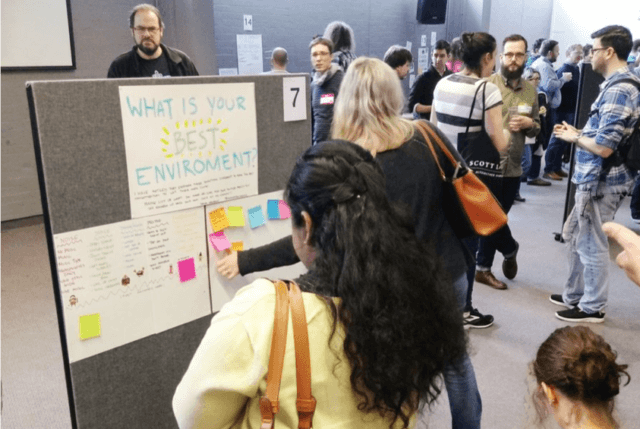Three better alternatives to the conference lecture

Rather than reiterate the shortcomings of broadcast-style teaching, I’ll go positive. Here are three better alternatives to the conference lecture.
As an example, I’ll use a three-day conference I’m currently designing. The participants are four hundred international scientists who only get to meet en masse every few years. It’s important to give them excellent opportunities to discover and connect with cross-disciplinary colleagues and ideas. They also need to share a massive amount of information about their current research in ways that maximize appropriate learning, fruitful connections, and future collaborations.
Here are three better alternatives to the conference lecture we’re using for the middle of the conference arc. In my experience, each of them is far more effective than a traditional conference lecture.
1 — Short bursts of varied content followed by breakouts
Most academic conferences schedule large numbers of simultaneous lectures. Instead, we’ve designed sessions with multiple short serial presentations, aka lightning or speed talks. By “short” I mean four minutes per scientist. After a batch of these talks, each presenter moves to a separate space in the room. Participants are then free to meet in small groups with the presenter(s) they chose for in-depth discussions.
We’ve scheduled 165 lightning talks grouped into 16 thematic sessions.
The four-minute time limitation nudges each presenter to focus on the core aspects of what they want to share and how to communicate them as effectively as possible in the time available. In addition, audience attention remains high because the presenter and their material is changing every five minutes, well within the ten minutes Bligh and John Medina cite as a maximum before listener attention flags.
Each session is assigned a facilitator, a timekeeper, and a staffer who projects a pre-assembled master presentation slide deck for the four-minute presentations.
2 — Poster sessions
Poster sessions are a variant of the above format. Presenters stand in front of a standard-size poster they’ve created that summarizes and illustrates their content. (We’re using e-posters, which not only eliminate the need for the presenters to print, pack, and securely transport a large poster to the conference but also make changing posters between sessions quick and efficient.)
One potential drawback of simultaneous sessions is that presenters can’t attend another presentation that’s taking place at the same time. In a thematic poster session, this prevents presenters from engaging with other presenters who are standing next to their own posters. To allow individual presenters the opportunity to engage with some of the other presenters and their content, we’ve divided each poster session into two 45-minute parts.
Each poster session begins with half the presenters giving a one-minute summary of their work/poster to everyone present. Attendees then spend the rest of the 45 minutes browsing content that interests them. The poster creator remains available for explanations, elaborations, and discussions as needed. The process is repeated for the second set of presenters.
The need to create and deliver an effective one-minute presentation concentrates a presenter’s mind wonderfully!
Each session is assigned a facilitator/timekeeper and a staffer who makes the appropriate e-posters available for the presenters.
We’ve scheduled 125 poster sessions grouped into 7 thematic sessions.
3 — In-depth interactive sessions led by one or more experts
In addition, this conference includes a small number of longer sessions on key organizational and science issues. The formats for these sessions vary, but they are all designed to incorporate ten-minute or shorter chunks of presented content or provocative questions interspersed with small group active learning activities.
Such sessions provide more effective and appropriate learning than a traditional lecture. They supply learning that is personalized, and that will be remembered longer, in greater detail, and more accurately.
Three better alternatives to the conference lecture
Given the sheer volume of information available from the assembled scientific minds at this event and the considerable investment of time and money to hold this conference, it’s important to use session formats like these three better alternatives to the conference lecture. They maximize rich knowledge transfer and the likelihood of making the kinds of “aha” connections that can lead to significant advances in the conservation work and research these scientists perform.
Image attribution: Marisha Aziz

 During my 20+ years as an IT consultant and developer, I fell in with a delightful international crowd of software testers: those all-important people responsible for the impossible task of making sure that software works the way it’s supposed to. (Fun fact: the testing community often uses my term “peer conferences” for their get-togethers, due to a chat about meeting design I had with tester
During my 20+ years as an IT consultant and developer, I fell in with a delightful international crowd of software testers: those all-important people responsible for the impossible task of making sure that software works the way it’s supposed to. (Fun fact: the testing community often uses my term “peer conferences” for their get-togethers, due to a chat about meeting design I had with tester